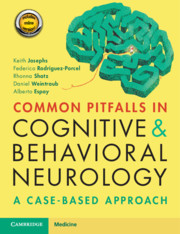Book contents
- Common Pitfalls in Cognitive and Behavioral Neurology
- Common Pitfalls in Cognitive and Behavioral Neurology
- Copyright page
- Dedication
- Contents
- Diseases Discussed in the Book
- Preface
- Acknowledgements
- Abbreviations
- Part 1 Missing the Diagnosis Altogether
- Part 2 Misidentifying the Impaired Cognitive Domain
- Part 3 Missing Important Clues in the History
- Part 4 Failure of Pattern Recognition
- Part 5 Difficult-to-Characterize Cognitive/Behavioral Disorders
- Part 6 Clinical Findings That Are Subtle
- Part 7 Misinterpreting Test Results
- Part 8 Attributing Findings to a Known or Suspected Disorder
- Part 9 Missing Radiographic Clues
- Case 41 Another Case of Vascular Cognitive Impairment?
- Case 42 Pseudoatrophic Pattern in Hydrocephalus
- Case 43 Parkinsonism, Ataxia, and Cognitive Impairment after Radiation Therapy
- Case 44 It’s Not Alzheimer Disease; Now What?
- Case 45 Getting the Full Picture
- Part 10 Management Misadventures
- Index
- Plate Section (PDF Only)
- References
Case 44 - It’s Not Alzheimer Disease; Now What?
from Part 9 - Missing Radiographic Clues
Published online by Cambridge University Press: 03 November 2020
- Common Pitfalls in Cognitive and Behavioral Neurology
- Common Pitfalls in Cognitive and Behavioral Neurology
- Copyright page
- Dedication
- Contents
- Diseases Discussed in the Book
- Preface
- Acknowledgements
- Abbreviations
- Part 1 Missing the Diagnosis Altogether
- Part 2 Misidentifying the Impaired Cognitive Domain
- Part 3 Missing Important Clues in the History
- Part 4 Failure of Pattern Recognition
- Part 5 Difficult-to-Characterize Cognitive/Behavioral Disorders
- Part 6 Clinical Findings That Are Subtle
- Part 7 Misinterpreting Test Results
- Part 8 Attributing Findings to a Known or Suspected Disorder
- Part 9 Missing Radiographic Clues
- Case 41 Another Case of Vascular Cognitive Impairment?
- Case 42 Pseudoatrophic Pattern in Hydrocephalus
- Case 43 Parkinsonism, Ataxia, and Cognitive Impairment after Radiation Therapy
- Case 44 It’s Not Alzheimer Disease; Now What?
- Case 45 Getting the Full Picture
- Part 10 Management Misadventures
- Index
- Plate Section (PDF Only)
- References
Summary
This 85-year-old right-handed man presented with a 5-year history of memory difficulties. His daughter described a slowly progressive decline in his ability to recall recent events. Initially, he repeated stories and frequently misplaced items. Within the prior two years, he forgot appointments and started adding notes to calendars. Otherwise, he remained very independent and active, exercising daily. He exhibited no motor or personality changes. The patient was not concerned about his difficulties and attributed them to normal aging. His only medication was tamsulosin for prostatic hyperplasia. His neurological exam was normal except for a Montreal Cognitive Assessment (MoCA) score of 25/30 due to impairments in delayed recall (he recalled one word freely; could not name the others even after category or multiple-choice cues) and orientation to time.
- Type
- Chapter
- Information
- Common Pitfalls in Cognitive and Behavioral NeurologyA Case-Based Approach, pp. 141 - 143Publisher: Cambridge University PressPrint publication year: 2020



